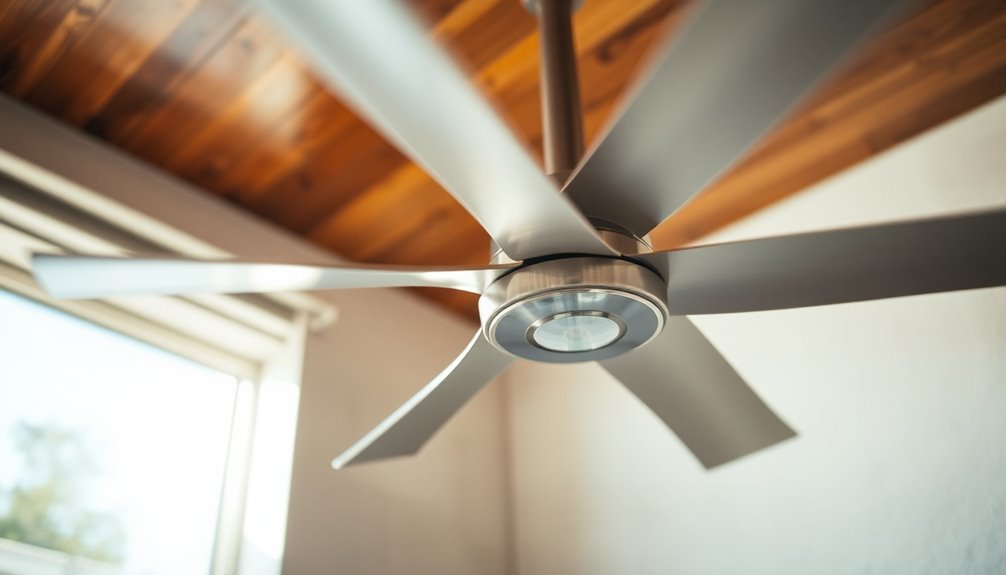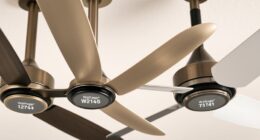While ceiling fans rarely fall, it's crucial to verify they're installed correctly to keep your space safe. Fewer than seven ceiling fan-related fatalities occur annually in the U.S., highlighting that with proper installation and maintenance, risks are minimal. Always use fan-rated outlet boxes and check for loose screws or bent blades regularly. If you notice wobbling or rattling, it might indicate a problem that needs your attention. Staying proactive with inspections can prevent accidents. Want to verify your fan's stability and safety? There's more valuable information to help you keep your fan secure and functioning well.
Key Takeaways
- Proper installation with fan-rated outlet boxes and secure mounting reduces the risk of ceiling fan falls.
- Regular inspections can identify loose screws and bent parts that may lead to instability.
- Ensure the fan is correctly balanced and free of dust to prevent wobbling that could cause detachment.
- Engage licensed electricians for complicated wiring or mounting tasks to ensure safety compliance.
- Signs of wear or unusual noises indicate the need for professional assessment to prevent potential falls.
Understanding Ceiling Fan Risks

When it comes to ceiling fans, understanding the risks is vital for your safety. While the chances of a ceiling fan fall exist, especially with improper installation, severe injuries from falling blades are quite rare if the fan is installed correctly.
The average number of reported ceiling fan-related deaths in the U.S. is fewer than seven annually, highlighting how uncommon these incidents are when you adhere to proper installation practices.
To minimize risks, verify your fan is securely mounted using a compatible mounting bracket and fan-rated box. Fans installed on non-rated boxes or lacking adequate support are at a heightened risk of failure.
Regular inspections are important; loose screws, bent blade holders, and improper mounting can lead to wobbling and potential detachment. By conducting routine maintenance checks, you can catch these issues before they escalate into dangerous situations. Additionally, ensuring your home has adequate insulation can help maintain a stable environment, reducing wear on ceiling fans.
Ultimately, following installation guidelines and performing regular upkeep greatly reduces the likelihood of accidents. By staying proactive about your ceiling fan's condition, you'll help guarantee a safe and comfortable environment in your home.
Causes of Ceiling Fan Wobbling

Causing frustration and potential safety hazards, ceiling fan wobbling can stem from several factors. Understanding these causes is vital to ensuring your fan operates smoothly and safely. Here are some common reasons for ceiling fan wobbling:
- Improper Installation: If the mounting bracket isn't adequately supported or if non-rated outlet boxes are used, it can lead to instability.
- Blade Imbalance: Bent blade holders or loose screws connecting the blades to the fan hub can result in an imbalance, causing noticeable wobbling.
- Dust Accumulation: Pressure imbalances on the fan blades due to dust build-up can exacerbate wobbling issues, affecting performance and safety.
- Lack of Maintenance: Over time, continuous movement may loosen mountings and screws.
Regular maintenance, like tightening screws and inspecting components, is essential to mitigate these problems.
How to Fix a Wobbly Fan

Addressing a wobbly ceiling fan is important for both comfort and safety. Start by ensuring the fan is completely stopped, then thoroughly inspect screws and connections for tightness. Loose screws can lead to instability, so make sure to tighten them as needed.
Next, check the mounting bracket. A loose mounting bracket is a common cause of wobbling, so secure it to the ceiling with tight screws.
After that, inspect the fan blades for any bends or warps. If you find damaged blades, replacing them will help restore proper balance and reduce wobbling.
Regular cleaning of the fan blades is also essential. Dust accumulation can affect balance, so use a vinegar solution or specialized cleaning agents to keep them clean.
If you've done all this and the wobbling persists, consider using a fan balancing kit. This kit typically includes weights that you can attach to the blades to help achieve uniform balance.
Importance of Proper Installation

Proper installation of a ceiling fan is vital for guaranteeing both safety and functionality. When you don't install your fan correctly, it can become loose and even fall, posing a serious risk.
To prevent accidents and guarantee your ceiling fans operate safely, consider these key points:
- Use a fan-rated outlet box: This guarantees your fan is securely mounted and adheres to safety standards.
- Engage licensed electricians: They've the expertise to install your fan correctly, reducing the risk of improper mounting techniques.
- Inspect mounting hardware regularly: Check for any signs of wear or loosening that could compromise safety over time.
- Follow installation guidelines: Adhering to clearance requirements and secure attachment methods is vital for maintaining the fan's integrity.
- Additionally, ensure that the ceiling fan is installed at the correct height to maximize airflow and minimize the risk of it becoming unstable.
Safety Guidelines for Installation

Guaranteeing your ceiling fan is installed safely requires adhering to specific guidelines that help prevent accidents.
First, make certain your fan is mounted a minimum of eight to ten feet above the floor. This height not only promotes ideal airflow but also helps avoid potential hazards.
When it comes to mounting, always use solid wooden joists or a fan-rated outlet box for stability. This step is essential for your fan's safety during operation.
Clearance is another important factor. Avoid installing ceiling fans in low-ceiling rooms to maintain adequate space between the blades and surrounding structures. This reduces the risk of accidents considerably.
Additionally, regularly inspect the mounting hardware and connections every six months. Look for any signs of wear, loosening, or damage that could compromise safety.
Lastly, review and follow the manufacturer's installation instructions carefully. Doing so guarantees compliance with safety standards and assures your fan's proper functionality.
Community Experiences With Fan Failures

You might be surprised to hear about the common installation mistakes that can lead to ceiling fan failures.
Many homeowners share their experiences of signs that indicated potential issues before a fan fell, highlighting the importance of vigilance.
Let's explore some safety precautions that could help prevent these incidents in your home.
Common Installation Mistakes
Often, ceiling fans fail due to common installation mistakes that many homeowners overlook. Understanding these pitfalls can save you from potential disasters.
Here are four key installation mistakes to watch out for:
- Non-rated Outlet Boxes: Installing your ceiling fan on an outlet box that isn't rated for fan support can lead to serious issues. Verify your box can handle the weight.
- Weak Mounting Brackets: Using metal brackets that can expand or weaken over time creates instability. Opt for sturdy brackets designed specifically for ceiling fans.
- Loose Screws: Failing to tighten screws in the mounting bracket is a frequent cause of wobbling. Always double-check that everything is secure before finishing the installation.
- Ignoring Building Codes: Neglecting to adhere to local building codes can increase the risk of failure. Always follow proper guidelines to verify a safe installation.
Signs of Potential Failure
What signs should you look out for to prevent a ceiling fan disaster? First, pay attention to any unusual noises or wobbling while the ceiling fan operates. These can be indicators of loose screws or worn-out mounting brackets. If you notice any screws that seem loose during your routine maintenance checks, tighten them immediately to avoid further issues.
Improper installation can also lead to failure, so make sure your fan is securely mounted to a fan-rated box rather than directly to joists. This is vital for stability.
Be aware that environmental factors, such as vibrations from nearby appliances or structural settling, can increase the risk of your fan detaching.
Additionally, users have reported that metal brackets are more prone to failure than plastic components. If your ceiling fan has metal brackets, consider replacing them or inspecting them more frequently.
While there haven't been serious injuries reported from falling fans, it's important to recognize these signs and take proactive steps. Regular maintenance and vigilance can help you enjoy your ceiling fan safely without the fear of it falling.
Safety Precautions Recommended
To guarantee your ceiling fan remains securely in place, it's important to adopt specific safety precautions based on community experiences with fan failures. Many users have reported issues stemming from improper installations, so following safety standards and installation guidelines is vital.
Here are some recommended precautions:
- Use Rated Mounting Boxes: Confirm that your ceiling fan is mounted on a box rated for fan support to prevent any risks of failure. Choosing a fan supported by a rated mounting box ensures stability and safety.
- Hire a Licensed Electrician: Engaging a licensed electrician for installation not only guarantees compliance with safety standards but also minimizes the chance of improper mounting. Additionally, they can help ensure that the installation meets local building codes to enhance overall safety. Proper installation techniques can help prevent issues similar to those faced with commercial HVAC systems.
- Conduct Regular Inspections: Check your fan periodically for any signs of looseness or wear, which can help identify potential issues before they escalate.
- Stay Informed on Local Codes: Awareness of and compliance with local building codes, like NEC 314.27, is important for safe installations and ongoing safety.
Additionally, ensuring that your fan is properly maintained can significantly reduce the risk of mechanical failures that lead to accidents.
Cleaning and Maintenance Tips

Keeping your ceiling fan clean and well-maintained is essential for its performance and longevity. Regular cleaning prevents dust accumulation on the blades, which can affect airflow and efficiency. A simple vinegar solution—10 ml of vinegar mixed with 50 parts water—works well for wiping down the blades. This not only keeps them clean but also helps maintain balance.
For stubborn dirt, use a toothbrush dipped in kerosene to scrub the blades, but make sure to rinse thoroughly afterward to eliminate any flammable residue. You can also use specialized cleaning agents by spraying them directly on the blade surfaces and wiping them with a dry cloth, avoiding harsh chemicals.
To enhance cleanliness and prevent static electricity, periodically soak a cloth in the vinegar solution and wipe the blades.
During your maintenance checks, don't forget to inspect and tighten all screws and mounting hardware. This guarantees your fan's stability, reducing the risk of wobbling or detachment.
Evaluating Fan Stability

When it comes to your ceiling fan's stability, proper installation techniques are essential.
You should regularly check for loose screws and guarantee all components are securely fastened to avoid any wobbling.
Proper Installation Techniques
How can you guarantee your ceiling fan remains securely in place? Proper installation is essential for stability. Here are four key techniques to follow:
- Use a fan-rated outlet box: Verify it's securely fastened to ceiling joists. This provides the necessary support for your ceiling fan's weight.
- Follow installation instructions: Pay close attention to the recommended tightening specifications for all screws and brackets. This minimizes the risk of wobbling and potential detachment.
- Conduct a visual inspection: Regularly check the fan's components, including bent blade holders or loose screws. These issues can contribute to imbalance and increase the likelihood of failure.
- Consider a retrofit ceiling fan brace: If you're installing in an older home, this can enhance safety by meeting current installation standards.
Regular Maintenance Importance
Regular maintenance is essential for guaranteeing your ceiling fan remains stable and secure. By regularly inspecting your fan, you can greatly reduce the risk of wobbling and potential falls. Aim to check the condition of your ceiling fan every six months.
During these inspections, tighten screws and examine the mounting bracket to catch any loose components early on. This proactive approach can help maintain stability and prevent accidents.
Additionally, cleaning dust from the fan blades is critical. Dust accumulation can affect balance, so keeping them clean guarantees proper functionality and minimizes wobbling. Remember, a well-maintained fan not only operates efficiently but also enhances safety.
It's also important to confirm your ceiling fan is installed according to manufacturer guidelines and local building codes. Proper installation is the foundation for long-term stability and safety.
Conduct thorough visual inspections of the mounting hardware and fan assembly to spot any installation issues that could lead to accidents. Additionally, consider using energy-efficient models to reduce wear and extend the life of your fan.
When to Seek Professional Help

Ceiling fans can be a great addition to your home, but knowing when to seek professional help is vital for safety and functionality. If you encounter any issues, don't hesitate to reach out to an expert.
Here are four situations where professional assistance is advisable:
- Wobbling or Rattling: If your fan wobbles or rattles during operation, it may indicate installation issues that need a professional assessment.
- Complicated Wiring: When undertaking installation or repairs involving complicated wiring or mounting, hire a licensed electrician to guarantee compliance with safety standards.
- Wear and Tear: If your fan is mounted on a non-rated outlet box or shows signs of wear, seeking professional help can prevent potential accidents.
- Inspection Hesitation: If you're uncomfortable performing inspections or maintenance tasks like tightening screws or rebalancing blades, it's best to consult a professional.
In cases where your fan has fallen or exhibits significant signs of damage, contacting an expert for evaluation and repairs is vital for safety. Additionally, regular maintenance and monitoring air quality indicators can help prevent issues before they become serious.
Don't compromise your peace of mind—get the help you need!
Frequently Asked Questions
What Are the Chances of My Ceiling Fan Falling?
When you think about the chances of your ceiling fan falling, it's important to take into account its installation.
If you've secured it with proper mounting brackets and a fan-rated outlet box, the risk is low. However, if it's mounted incorrectly or hardware isn't tightened, problems can arise.
Regular inspections and maintenance help guarantee everything's secure.
How Do I Know if My Fan Is Going to Fall?
To know if your fan's going to fall, inspect the mounting bracket for tightness and stability.
Look for any signs of wear, like bent blade holders or cracks. Make certain it's installed on a fan-rated outlet box.
Listen for unusual noises, such as rattling or wobbling, during operation.
Regularly check every six months to guarantee everything's in good condition, preventing potential issues and keeping your space safe and comfortable.
Will a Ceiling Fan Fall if It Wobbles?
A wobbly ceiling fan might seem concerning, but it doesn't necessarily mean it'll fall. If it's been installed correctly and securely, the chances of it detaching are low.
However, you should check for loose screws or bent blade holders, as these can cause wobbling. Regular inspections and addressing any issues can help maintain stability and guarantee your fan operates safely, reducing the risk of accidents.
Keep an eye on it!
When Should I Worry About My Ceiling Fan?
Did you know that around 10% of ceiling fans experience issues due to improper installation?
You should worry about your ceiling fan if you notice significant wobbling, unusual noises, or rattling during operation.
Check for loose screws in the mounting bracket and guarantee it's securely attached to a fan-rated outlet box.
If your fan's older, consider having it inspected, as outdated mounts may not meet current safety standards, increasing the risk of failure.
Conclusion
In the dance of blades and air, your ceiling fan spins like a dream, but safety is the anchor that keeps it grounded. By ensuring proper installation and regular maintenance, you're weaving a tapestry of security in your home. Just as a sturdy tree stands tall against storms, your fan can be a steadfast companion, not a falling leaf. Trust your instincts, and if doubts arise, don't hesitate to bring in the experts, protecting your haven from unexpected shadows.









